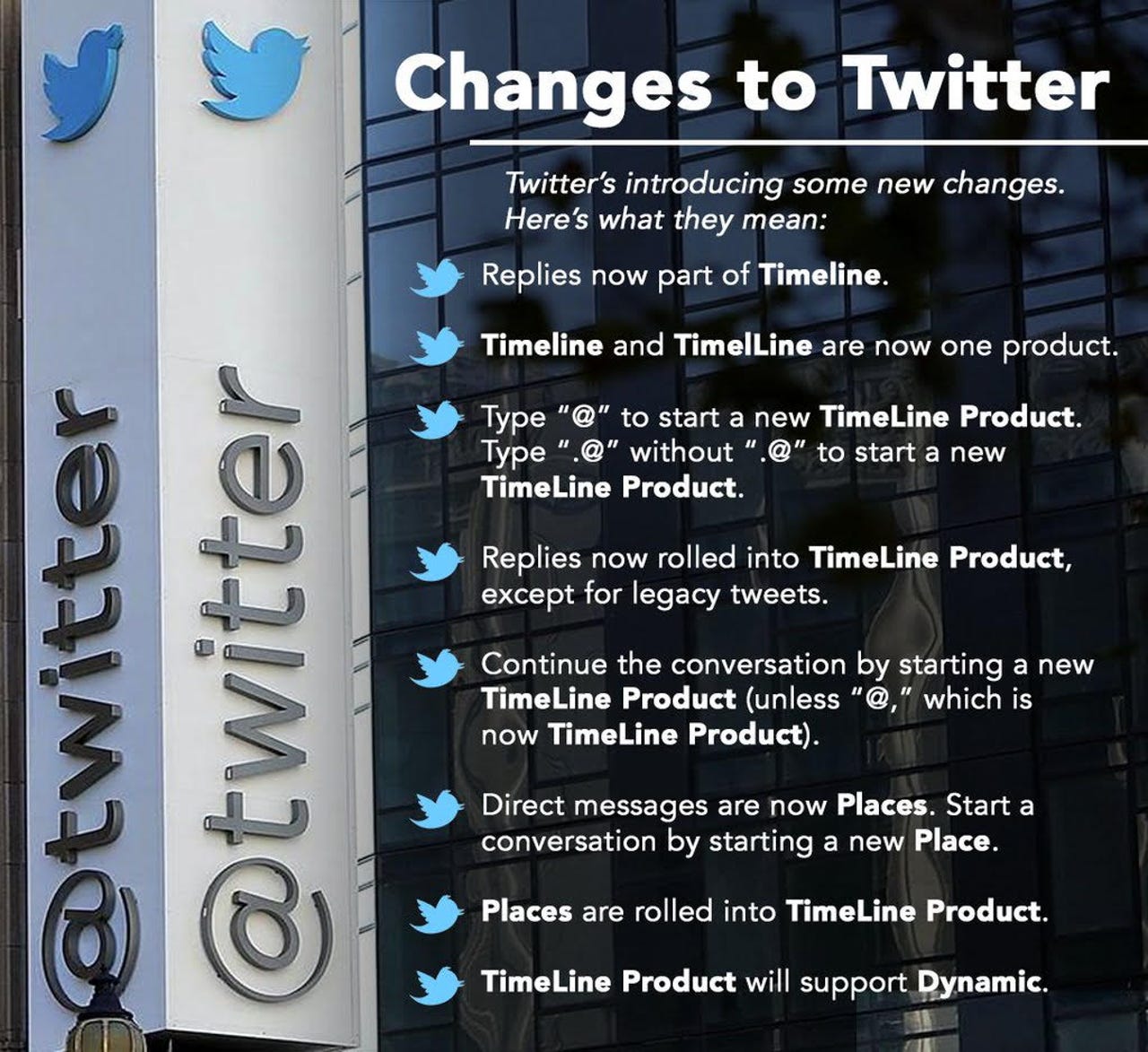Fiddle with something long enough, Twitter, and it'll break

Any sufficiently advanced parody is indistinguishable from reality. That's an extreme paraphrase of Poe's Law, but it applies to so much of our world today. Including the management of Twitter.
On Thursday, Twitter announced more changes to the way it works. Soon after, an image started circulating which supposedly explained these changes. And it was so confusing.
"Replies now part of Timeline. Timeline and TimelLine are now one product," it said. "Type '@' to start a new TimeLine product. Type '.@' without '.@' to start a new TimeLine product."
And so on, ending with an equally opaque declaration, "TimeLine Product will support Dynamic".

Changes to Twitter
The image is actually a parody, created by Jon Bois back in May 2016. But it fooled a lot of people this week before being debunked. Including me. Including quite a few others who should've figured it out.
If so many people could believe that this obvious-in-retrospect parody could be a real Twitter announcement, what does that say about the company's reputation for serving and communicating with its customers?
The real changes are listed in Twitter's announcement, so I won't repeat them here. But what actually drove these changes?
"The updates we're making today are based on feedback from all of you as well as research and experimentation. In our tests of this new experience, we found that people engage more with conversations on Twitter," product manager Sasank Reddy wrote.
I'm not sure which "all of you" told Twitter you wanted this, but I really don't care whether people "engage" with conversations or not. I'm conversing publicly, and anyone can join in, but that's up to them.
The only kinds of people who care about "engagement" are the kinds of people who use words like "engagement".
So that'd be advertisers and other corporate users, who want more eyeball love for the money and effort they put into their Twitter presence.
And that'd be Twitter itself, a platform that needs more eyeball love to justify its $15-and-declining share price -- especially to the investors who bought in when Twitter was supposedly worth more than $50 a share.
Want to see exactly who these changes are serving? Look at the replies to Twitter's tweet. A string of congratulatory messages that, entirely by coincidence, are all from sports teams.
Twitter is starting to look desperate, with its seemingly random series of changes that affect the nature of the platform's experience, its inability to stop abuse in any meaningful way, and its inability to get rid of the obvious spambots and other machines, which make up an estimated 15 percent of all accounts. But hey, abusers, robots, whatever, they're all users, and it is all engagement time.
Twitter should be desperate.
Back in 2012, Twitter killed off its third-party developer ecosystem. It had decided to be an advertising-driven media company, not a user-driven social messaging platform. Had Twitter signed its own death warrant, I wondered.
"Twitter is now [July 2012] valued at US$8.4 billion, following a US$300 million investment in December 2011 from Saudi prince Alwaleed bin Talal. The company hopes to float on the stock market in a year or so, yet its estimated revenues in 2011 was a mere US$140 million, expected to grow to only US$260 million in 2012. That will need to improve to prevent Twitter's share price doing a Facebook-plummet," I wrote.
Well Twitter isn't dead yet, but big businesses often die a slow death.
In 2015, Prince Alwaleed doubled his stake, and Twitter Moments was billed as the key to the company's resurgence. In November 2016, just four months ago, Alwaleed said that Twitter's best days are still to come. But then he would say that, assuming that he wants to ever see his money again. Now every social media platform needs eyeball love to survive. Last week, for example, LinkedIn introduced a trending topics feed. And Facebook is forever fiddling with its feed and other features.
But Twitter faces an extra obstacle. While LinkedIn and Facebook have an obvious focus, on users' professional and private lives respectively, Twitter is still missing a clear answer to that vital question: What is it for?
Is Twitter for individuals and small groups to hold conversations? For professionals to share information? Businesses to provide user support? News and sports mastheads to highlight their stories? Celebrities to spray their wisdom at their fans?
If Twitter wants to optimise for all these things, then it's really optimising for none.
Perhaps Twitter would have been better as that social messaging back-end as a service, pulling in revenue from a Cambrian explosion of innovative third-party service providers, without taking on their individual risk. That's the lesson of George Westinghouse.
But no, they wanted to be a media player. And here we are.
Meanwhile Twitter's chief executive officer Jack Dorsey is busy plugging his other baby, payments processor Square, as it expands operations into the UK. He's upbeat too, of course, ignoring the constant pressure to quit one of the companies to concentrate on the other.
"I'm going to do whatever it takes to make sure both succeed," Dorsey told CNBC on Tuesday.
Whatever it takes except resign, anyway.
As I've written before, beware of Startupland's hero entrepreneurs, who imagine the world can't run without them. Right, Jack?